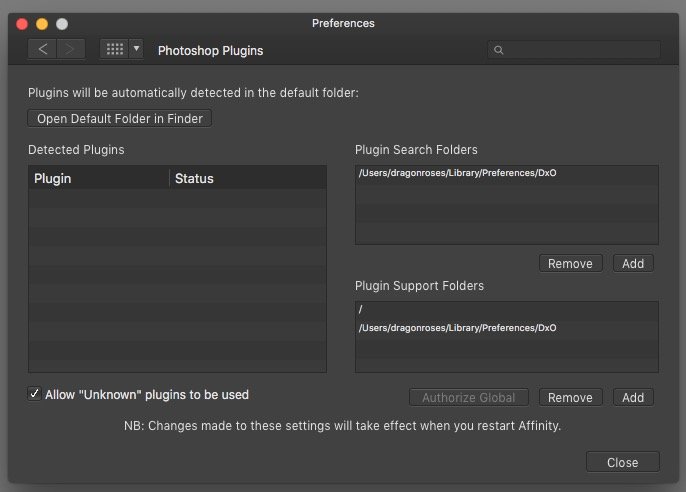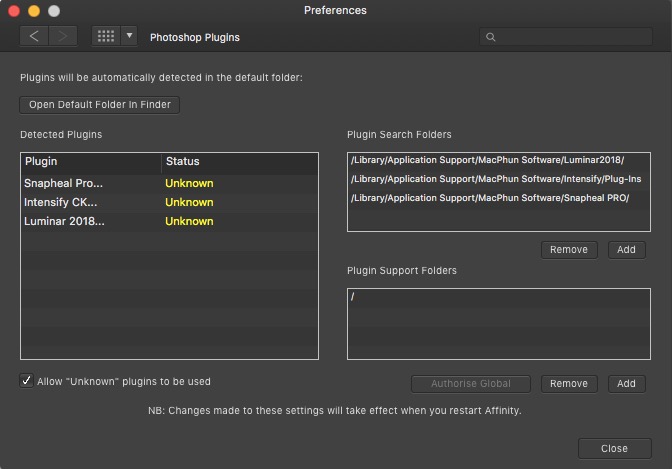
allfive
Members-
Posts
25 -
Joined
-
Last visited
Everything posted by allfive
-
Walt, THANKS! I think if would be helpful to many if Affinity gave more detail on LUTS in their "Guide to add ons" page under "Add on Types", i.e., that they are adjustments, and include a link to a simple how-to about loading them after the download. I've been using Affinity since the beginning so maybe that shows I've haven't learned much since then. Thanks again for your prompt help!
-
I made a download of Ivan Weiss's LUT pack from within the Affinity Photo app account window and got the green arrow. I can't find the LUT pack. I restarted the app, opened the Assets window. Blank. I read the posted Add On instructions on the Affinity web page. Didn't help. Tried to find "Refresh Library" in Preferences but there are a lot of choices but I couldn't find it. Searched my Mac for "top 9 LUT pack" and "Ivan Weiss" and find nothing. After a lot of trying, I'm now asking for help here. Please. Affinity Photo v2.1.1 Mac OS 12.6.8 Thank you.
-
Hens, thank you for clarifying the distinction for me, enough so that I can now select multiple adjustment layers. I really don't understand the functional difference between clipped and masked positions but I'll do the work to find out. If memory is correct, I recall that all of James' tutorials talked about offering an adjustment layer to the vertical blue line, and in those instances it appeared that multiple layers were selectable. Whether my memory is accurate or not, that's what I adopted. 😁
-
Topaz offers instructions for attaching their app as a plugin to AF. https://help.topazlabs.com/hc/en-us/articles/360001129351-Serif-Affinity-Photo-Using-Your-Topaz-Labs-Plug-ins When working in AF, I invoke the Sharpen AI app with the image I have open and the app connects as a plugin and launches fine. The problem is, it is non-functional - does not process anything. I've sent this on to Topaz and am awaiting their reply, but I wonder if there is any knowledge about this with AP people. Thanks.
-
Thanks, mikerofoto. Nik support could have outright told me to do an uninstall / reinstall, which they finally got around to saying. Parenthetically, it's quite easy to add DxO's Nik to CaptureOne without any pre-install steps. I hope the workaround needed for Affinity doesn't kill that connectivity ease my Nik plugins have with CaptureOne. I'm not casting aspersions on Affinity, which I love, and will gladly go thru the hoops to hook it up with Nik.
-
Am I missing a key point here? My original question was about connecting Nik to Affinity after an installation where the plugin step was not done - IOW, special folder not created. Watching James' video, am I to understand the ONLY way Affinity can access the Nik plugins is during the initial Nik installation? Therefore, I need to do a reinstall. Yes?? If so, I assume I should do an uninstall so as not to orphan the reference files and the original plugins folder? Has anyone done the uninstall? I still have the original 32-bit Google plugins from a decade ago connected to my Aperture install, and don't want to lose them by chance just yet. (Soon I will switch over to another library app but until then….) Thanks.
-
Thank you, John. The Nik plugins themselves are in (Hard drive)/ User>Library>Preferences>DxO, which I specified in the screen cap. However, I discovered another DxO folder in the root Library>Preferences that contains empty folders for all the plugins and a Nik Collection folder containing NikCollection.cfg.
-
Thanks MEB for your comment and link. I shall bookmark it and follow. RE: follow the nik video tutorial. I really appreciate the video tutorials. Most all are quite clear and very helpful. However, I watched the Nik tutorial several times and tried installing Nik several times but apparently missed the important detail of where to install "plugins". The example given of installing a plugins folder on the desktop is not helpful because no one, I think, would install it on the desktop. AP seems to create a default "plugins" folder somewhere in the Library (where System or User library I don't recall at the moment). Why not a suggestion or two in the tutorial about where it would make sense to install a plugin folder and what best to name the folder? Also, I think the point needs to be made in the tutorial that there is a distinction between plugin files and application files because most of us think of Nik as plugins. (I've had Nik plugins installed in Aperture for years and love them.) And the problem with my Nik install may be complicated by my long-standing install of the Nik plugins in Aperture, so I think that would be a topic for another thread about "double installs", but after my confusion settles. Thanks to all the others who commented. I'm in transition as to workflow. As a long time Aperture user, I'm used to moving back and forth among Nik and other plugins accessible from within Aperture. However, over the past few years, I've adopted DxO for NEF RAW processing. The Nik collection, as you know, is integrated in DxO's latest version but I find it a little awkward to use there. Nonetheless, I export from DxO and open in AP and continue processing. I love AP. The exception to that workflow is in RAW processing of early ORF files that DxO does not support, and I find AP really helpful there for RAW development and further refinement. RE: Luminar 2018 Strangely, I had Luminar (pre-2018) working with AP. I don't remember what steps I took, but I think I just indicated the location of the Luminar app in the first "add" box. However, Luminar 2018 is a no-go. Keep up the good work, Affinity. I look forward to better plugin integration.
- 23 replies
-
- snapheal
- intensityck
-
(and 1 more)
Tagged with:
-
Major frustration. I've been over the tutorial for Nik plugins many times (installing nik will need a separate thread) and it looks like I've connected SnapHeal Pro, Intensify CK, and Luminar 2018 correctly. However, when I call them up, I get the "Plugin started" popup but nothing happens. Eventually I need to force quit AP move on with my work. I think the documentation about regarding specific plugins really needs to be created and easily found. Mac El Capitan
- 23 replies
-
- snapheal
- intensityck
-
(and 1 more)
Tagged with:
-
Support for External Editor
allfive replied to Roaring Fish's topic in Older Feedback & Suggestion Posts
I suppose being able to access Affinity from Aperture is out of the question? Some of us still rely on Aperture as the basic organizing/metadata/export app, especially those who have huge libraries, as I do. -
In my preferences (v. 1.4.1), I have UNchecked "convert opened files to working space". (Importing a 16-bit Beta RGB TIFF (doesn't matter what file type or from where) exported from DxO Optics Pro, I get automatically converted to sRGB. I also get the dialog pop-up telling me it converted to sRGB because the imported file is unprofiled.) CORRECTION: If sRGB is imported into Affinity, I get the dialog popup telling me sRGB was automatically assigned because the file had no profile. If Beta RGB, or other, is imported, for instance, no conversion takes place (I assume) and I'll be working in Beta RGB space. Correct? Can you clear this up? Thank you.
-
I need to move from Aperture but I have hundreds of gigs in my Aperture library. How can I work from the Aperture library? At this point many people have large libraries with full metadata support. Their folder structures are dependent on the app that created them. What is the best workaround for effectively opening work in AP in that scenario? I assume you will not make a plugin for Aperture, but what cataloging apps besides Lightroom do you see supporting?



